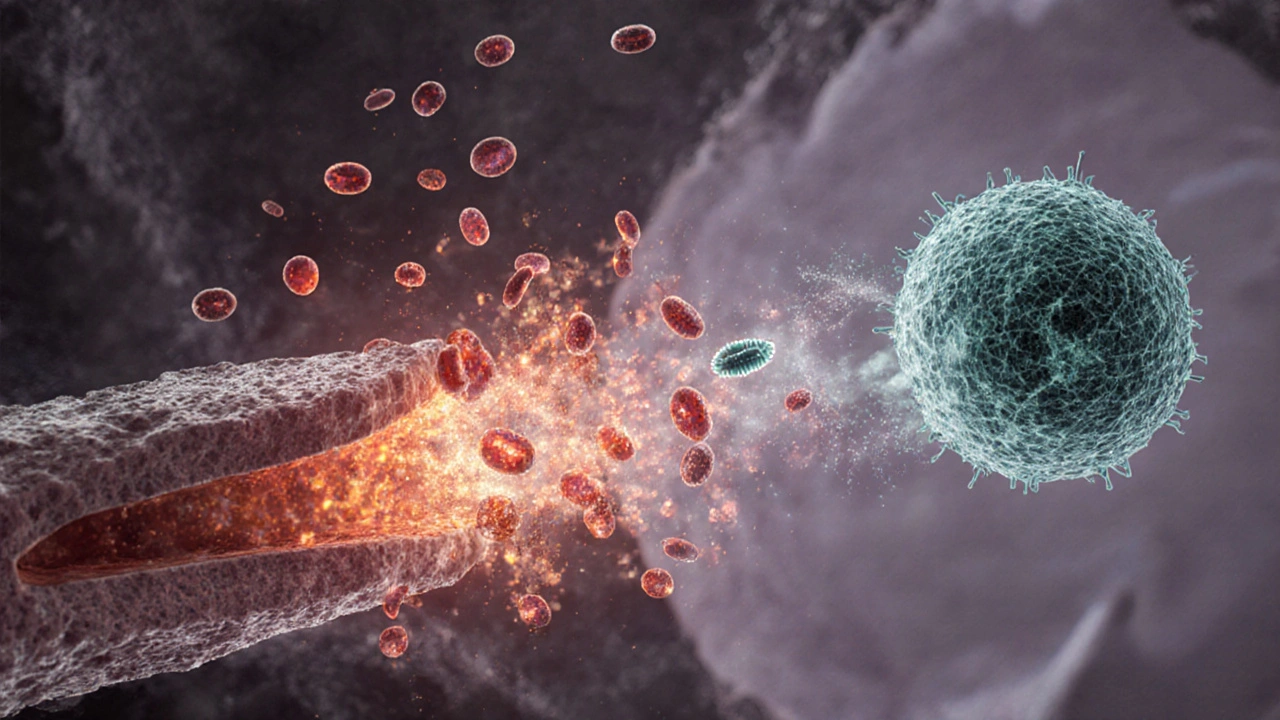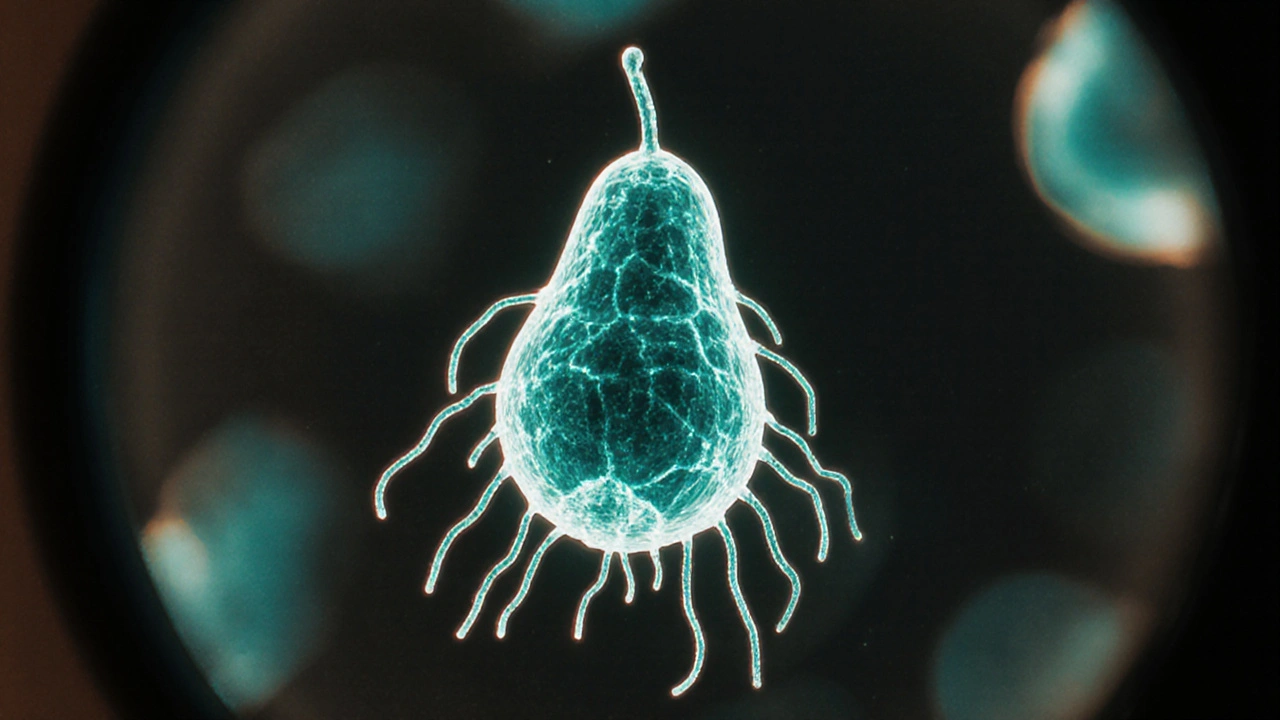Trichomoniasis Immune Response Simulator
Select an immune component below to see how trichomoniasis affects it:
Neutrophils
First responders that engulf pathogens
Macrophages
Engulf microbes and present antigens
Cytokines
Signaling molecules that regulate inflammation
Th1 Cells
Cell-mediated immunity and macrophage activation
Th2 Cells
Promote antibody production
Microbiome
Vaginal bacterial ecosystem balance
Impact on
Quick Summary
- Trichomoniasis is a common STI caused by the parasite Trichomonas vaginalis.
- The infection triggers a rapid innate immune response, releasing cytokines like IL‑1β and TNF‑α.
- Repeated or untreated infection can shift the balance of adaptive immunity, weakeningTh1responses and raising susceptibility to other infections.
- Inflammation disrupts the vaginal microbiome, creating a feedback loop that fuels more inflammation.
- Effective treatment (e.g., metronidazole) and targeted nutrition can help restore immune balance.
What Is Trichomoniasis?
When you hear the term Trichomoniasis is a sexually transmitted infection caused by the flagellated protozoan Trichomonas vaginalis. It spreads through vaginal, oral, or anal sex and can affect anyone with a penis or vagina. In the UK, about 1% of sexually active adults carry the parasite, but many cases go undiagnosed because symptoms can be mild or absent.
Typical signs include itching, burning, unusual discharge, and discomfort during urination. Men often report irritation inside the urethra or a mild discharge from the penis. The infection is treatable, but if left unchecked it can linger for months, continuously stimulating the immune system.
How the Immune System First Notices the Parasite
The body's first line of defense is the innate immune system. Epithelial cells lining the vagina act like sentries, spotting the parasite’s surface proteins via pattern‑recognition receptors (PRRs) such as toll‑like receptors (TLR‑2 and TLR‑4). Once engaged, these cells release a burst of cytokines-IL‑1β, IL‑6, and tumor‑necrosis factor‑alpha (TNF‑α)-that call in immune troops.
Neutrophils arrive within minutes, attempting to engulf the motile T. vaginalis. Unfortunately, the parasite has evolved mechanisms to avoid being killed: it can secrete cysteine proteases that degrade neutrophil enzymes, and it produces a surface lipophosphoglycan that masks it from recognition.
Macrophages also get involved, producing reactive oxygen species (ROS) and nitric oxide. While these chemicals can damage the parasite, they also stress surrounding tissue, setting the stage for chronic inflammation if the infection persists.

Cytokine Landscape During Infection
Researchers tracking cytokine levels in infected patients have identified a distinct profile. Early infection spikes IL‑1β and TNF‑α, which drive inflammation and pain. By the second week, IL‑8 rises, attracting more neutrophils, while IL‑10-a regulatory cytokine-begins to increase, attempting to dampen the response.
This mixed‑signal environment is a double‑edged sword. High pro‑inflammatory cytokines help clear the parasite but also cause tissue damage and alter the vaginal epithelium, making it more permeable to other microbes. Elevated IL‑10 can suppress the Th1‑type response essential for long‑term immunity, leaving the host vulnerable to reinfection.
Impact on Adaptive Immunity
Adaptive immunity involves B‑cells producing antibodies and T‑cells orchestrating targeted attacks. In trichomoniasis, the antibody response is surprisingly weak. Most people develop low‑titer IgA and IgG that fail to neutralize the parasite effectively. This is partly because the parasite changes its surface antigens-a process called antigenic variation-making it a moving target for antibodies.
On the T‑cell front, the infection skews the balance toward a Th2‑type response, which favors antibody production over cell‑mediated killing. The reduced Th1 activity means fewer interferon‑γ (IFN‑γ) producing CD4+ T‑cells, which are crucial for activating macrophages and clearing intracellular pathogens.
As a result, people who experience repeated trichomoniasis episodes often show a blunted cellular immune profile. Some longitudinal studies have linked chronic infection with a modest decline in CD4+ T‑cell counts, especially in individuals co‑infected with HIV.
Broader Immune Consequences
Beyond the immediate fight, trichomoniasis can reshape the entire vaginal ecosystem. Inflammation disrupts the protective Lactobacillus‑dominated microbiome, allowing overgrowth of anaerobes like Gardnerella and Prevotella. This dysbiosis further fuels cytokine production, creating a vicious cycle.
The inflammation also raises the risk of acquiring other sexually transmitted infections. A meta‑analysis of 15 studies found that women with trichomoniasis were 2-3 times more likely to contract HIV, largely because the inflamed mucosa presents more entry points for the virus.
In men, chronic infection can lead to prostatitis‑like symptoms and has been associated with an increased likelihood of urethral stricture, both of which reflect persistent immune activation.

Supporting Your Immune System During and After Treatment
Clearing the parasite with a single dose of metronidazole (or a 7‑day course of tinidazole) removes the primary trigger. However, the immune system may need help bouncing back.
Here are evidence‑backed steps you can take:
- Re‑establish a healthy microbiome: Probiotic supplements containing Lactobacillus crispatus or fermented foods (yogurt, kefir) can repopulate protective bacteria within weeks.
- Boost anti‑oxidant defenses: VitaminsC andE, plus foods rich in polyphenols (berries, green tea), neutralize ROS generated during inflammation.
- Balance cytokine production: Omega‑3 fatty acids from fish oil or flaxseed have been shown to lower IL‑6 and TNF‑α levels.
- Stay hydrated and rest: Adequate sleep supports the production of interferon‑γ, helping restore the Th1 response.
- Practice safe sex: Using condoms until both partners test negative prevents reinfection and protects against other STIs.
If you have a compromised immune system (e.g., HIV+, organ transplant recipients), discuss with your clinician the possibility of a repeat test three weeks after treatment to confirm clearance.
Quick Reference Table - Immune Components vs. Trichomoniasis Impact
| Immune Component | Normal Role | Effect of Trichomoniasis |
|---|---|---|
| Neutrophils | First responders, phagocytose pathogens | Recruitment ↑, but parasite proteases reduce killing efficiency |
| Macrophages | Engulf microbes, present antigens | Activation ↑ with ROS, leading to tissue irritation |
| IL‑1β / TNF‑α | Drive inflammation, fever | Early surge → pain, mucosal damage |
| IL‑10 | Regulates inflammation | Elevated later, suppresses Th1 response |
| Th1 Cells (IFN‑γ) | Cell‑mediated immunity, activates macrophages | Activity ↓, impairing long‑term clearance |
| Th2 Cells (IL‑4/IL‑5) | Promote antibody production | Shift ↑, but antibodies remain low‑titer |
Frequently Asked Questions
Can trichomoniasis make me more likely to get the flu?
The infection primarily affects the genital tract, so it doesn’t directly increase flu risk. However, any chronic inflammation can slightly divert immune resources, which might make you feel a bit more vulnerable during peak flu season.
Do men experience the same immune changes as women?
Men do mount an innate response with neutrophil recruitment, but the vaginal‑specific microbiome shift isn’t a factor for them. Some studies suggest men may have a milder cytokine surge, yet chronic infection can still cause prostatitis‑like inflammation.
How soon after treatment will my immune system reset?
Inflammatory markers typically fall within 1-2 weeks post‑treatment, but restoring a healthy Lactobacillus‑dominant microbiome can take 3-4 weeks. Probiotic support speeds this process.
Is there a vaccine on the horizon?
Researchers are exploring a subunit vaccine targeting the parasite’s cysteine protease, but as of 2025 it remains in early‑phase trials. Till then, safe sex and prompt treatment are the best defenses.
Can I still get pregnant after a trichomoniasis infection?
Yes, the infection itself doesn’t block conception. However, persistent inflammation can affect cervical mucus quality, so it’s wise to treat the infection and allow a couple of menstrual cycles before trying to conceive.


Comments
Jonathan Seanston
Hey folks, have you ever wondered why a simple STI can mess with your whole immune orchestra? The guide nails how Trichomonas pulls a fast one on neutrophils, sending them in but then jamming their enzymes. It also shows the cascade where cytokines go wild, making you feel that burning ache. I’ve seen patients swear off antibiotics, only to get caught in that inflammatory loop again. Bottom line, treating the bug is just the first step; you gotta give your immune system a chance to reset.
October 9, 2025 at 14:59
Sukanya Borborah
Yo, this piece throws a lot of jargon at us-cysteine proteases, IL‑10, Th2 skewing-without the fluff. The micro‑ecosystem angle is spot on; dysbiosis is basically the silent accomplice. Still, the language could use a breather; it reads like a lab report. That said, the probiotic recs are practical, so you can actually apply them. In short, the science is solid, but the prose feels like a marathon.
October 9, 2025 at 20:32
Greg RipKid
Interesting breakdown. The timeline of cytokine spikes makes sense with what I've seen in clinic. It’s good that the article mentions both short‑term pain and long‑term microbiome shifts. Also, the tip about omega‑3s for lowering IL‑6 is handy. Overall, a useful quick‑reference for anyone dealing with trich.
October 10, 2025 at 02:06
Nadia Stallaert
Listen, the whole "immune system" narrative is part of the grand design to keep us docile, isn't it? They tell us that cytokine surges are just a harmless side‑effect, but those molecules are signal beacons for deeper control mechanisms. The fact that Trichomonas can manipulate neutrophil enzymes suggests an engineered symbiosis, not a random parasite. Think about the timing: the early IL‑1β storm is perfect for creating a window where other pathogens can slip through. And the later IL‑10 rise? Purely a dampener to stop us from mounting a proper Th1 response, ensuring we remain susceptible. They even mention microbiome disruption-an obvious lever to keep the host dependent on external interventions. It's all part of a feedback loop designed by those pulling the strings behind the scenes. If you read between the lines, the article is essentially a manual for how to keep the populace in a perpetual state of low‑grade inflammation, making us easy to manage.
October 10, 2025 at 07:39
John Price Hannah
Wow-talk about drama! The parasite is like a sneaky thief, stealing the spotlight from our immune defenders, then vanishing before the applause. Those proteases are the party crashers, and the Th2 shift? Pure melodrama. I love how the guide spells out the “vicious cycle” with such flair-makes the science feel like a thriller.
October 10, 2025 at 13:12
Echo Rosales
Honestly, the whole thing seems over‑hyped. Most people clear the infection without any of these cascading effects. I think the author is just trying to make a simple STI sound like a world‑ending catastrophe.
October 10, 2025 at 18:46
Bridgett Hart
While the analysis is thorough it fails to address the psychosocial impact of chronic infection on patients who already feel stigmatized.
October 11, 2025 at 00:19
Sean Lee
From a systems‑biology perspective, the described shift from Th1 to Th2 represents a classic example of immune plasticity under sustained antigenic pressure. The feedback inhibition via IL‑10 is a regulatory node that, if perturbed, can destabilize the entire cytokine network. This underscores the importance of temporal profiling in therapeutic interventions.
October 11, 2025 at 05:52
Michael Christian
Great tips! I’ve started adding kefir to my diet after treatment and already feel less irritation. Keep sharing this kind of hopeful, actionable info.
October 11, 2025 at 11:26
Steven Elliott
Oh sure, because probiotics are the miracle cure for everything-except maybe a broken heel. Nice try, but the real fix is just taking the meds and moving on.
October 11, 2025 at 16:59
Lawrence D. Law
From a national health standpoint, it is imperative that we prioritize STI screening programs; the immune ramifications outlined here exemplify a public‑health threat that must be met with decisive policy action; early detection and treatment are non‑negotiable.
October 11, 2025 at 22:32
Mary K
The philosophical angle of how a microscopic parasite can rewrite our immune narrative is fascinating. It shows that even the smallest entities can wield disproportionate influence over our biological destiny. The piece does a stellar job of weaving scientific rigor with a touch of poetic wonder, reminding us that science is not just cold data but a story of survival.
October 12, 2025 at 04:06
Odin Zifer
Don't be fooled; these “studies” are funded by pharma to keep us buying endless supplements. The real agenda is control, not cure.
October 12, 2025 at 09:39
Marisa Leighton
First off, let me say how proud I am of anyone who’s taken the time to actually read through this dense guide-knowledge is power, especially when it comes to our bodies. The way the article maps out each immune player feels like you’re watching a backstage tour of a concert, where every instrument has its moment to shine or falter. I loved the clear explanation of neutrophils racing in like first‑responders, only to get hamstrung by the parasite’s crafty proteases; it’s a vivid reminder that even our fiercest defenders can be outsmarted. The macrophage saga, with its reactive oxygen species fireworks, paints a picture of a double‑edged sword-fighting the invader while risking collateral tissue damage. When you get to the cytokine roller‑coaster, the early IL‑1β and TNF‑α surge feels like a fire alarm blaring in a quiet house, jolting us awake to danger. Then the gradual rise of IL‑10 acts like the soothing voice that says, “Calm down,” but in doing so, it pulls the plug on the Th1 engine we need for lasting immunity. The shift toward a Th2‑dominated response is especially eye‑opening; it’s like the immune system swapping a rugged, all‑terrain vehicle for a sleek but under‑powered sedan that can’t tackle the rough road of persistent infection. The article also nails the microbiome angle-once the Lactobacillus stronghold crumbles, opportunistic bacteria take over, turning the vaginal environment into a chaotic battlefield. I appreciate the practical section on probiotic and omega‑3 support; it gives readers real, actionable steps to rebuild that microbial fortress. The advice to stay hydrated, rest well, and get enough sleep hits home, because we often overlook those basics in favor of flashy treatments. And let’s not forget the safety tip about retesting for immunocompromised folks-an essential reminder that one‑size‑fits‑all doesn’t apply in medicine. All in all, this guide is a comprehensive map for navigating the hidden war occurring beneath the surface, empowering us to fight smarter, not just harder. Keep sharing these thorough, balanced resources; they make a real difference in how we approach our health.
October 12, 2025 at 15:12
Brennan Keeler
Interesting read.
October 12, 2025 at 20:46